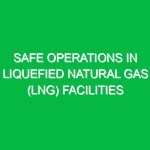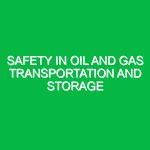Introduction
In the oil and gas industry, contractor safety management plays a crucial role in ensuring the health, safety, and environmental (HSE) integrity of operations. With a workforce that frequently relies on contractors for specialized skills, managing safety becomes a multifaceted challenge that must address various risks and hazards. The oil and gas sector is notoriously hazardous, with potential dangers lurking at every turn. Therefore, effective contractor safety management is not just a regulatory requirement; it is a moral imperative that can save lives and protect the environment.
Contractor safety management involves the systematic approach to managing contractors who perform work on behalf of an organization. This includes the development of safety policies, training programs, risk assessments, and compliance with legal regulations. By implementing robust safety management practices, organizations can minimize the likelihood of accidents, injuries, and environmental harm. As someone who has witnessed the repercussions of inadequate safety protocols firsthand, I can attest to the importance of prioritizing contractor safety in this industry.
Identifying Hazards and Risks in Contractor Safety Management
The oil and gas industry is fraught with risks, many of which are amplified when contractors are involved. Understanding these hazards is the first step in effective contractor safety management.
Physical Hazards
Physical hazards are among the most evident risks. These include slips, trips, falls, and equipment-related injuries. For instance, a contractor working on a drilling rig may face the risk of falling from heights. In one incident, a contractor failed to secure their harness properly, leading to a fall that resulted in severe injuries. Such incidents underscore the need for strict adherence to fall protection measures.
Chemical Hazards
The oil and gas sector frequently involves the handling of hazardous materials, such as hydrocarbons and various chemicals used in drilling and production. Exposure to these substances can lead to serious health issues, including respiratory problems and skin disorders. A notable example occurred when a contractor mishandled a chemical spill, resulting in not only health complications for workers but also significant environmental damage.
Environmental Hazards
Environmental hazards, including oil spills and gas leaks, pose a dual threat to both safety and ecological systems. The repercussions of such incidents can be catastrophic, affecting local wildlife and communities. A case study from the Gulf of Mexico highlighted the disastrous effects of a contractor’s failure to follow spill response protocols, leading to long-term damage to marine ecosystems.
Psychosocial Hazards
The pressures of working in high-stress environments can lead to psychosocial hazards. Contractors may face mental health challenges due to long hours, isolation, or job insecurity. Recognizing these risks is essential for creating a supportive workplace culture. In my experience, companies that offer mental health resources and promote open communication tend to have more engaged and safer workforces.
Best Practices and Safety Precautions
Once the potential hazards have been identified, it’s crucial to implement effective safety precautions. Here are some actionable strategies for enhancing contractor safety management in the oil and gas industry.
Thorough Pre-Qualification Processes
Before hiring a contractor, organizations should conduct rigorous pre-qualification processes. This includes evaluating a contractor’s safety record, training programs, and compliance with safety standards. For instance, one company I worked with required contractors to submit detailed safety plans and proof of safety certifications before bidding on projects. This proactive approach significantly reduced incidents on-site.
Comprehensive Training Programs
Training is essential for ensuring that contractors understand the specific risks associated with their tasks. Regular safety training sessions should be mandatory, covering topics such as hazard recognition, emergency response, and equipment operation. Interactive training methods, like simulations and hands-on workshops, can enhance retention and engagement.
Regular Safety Audits and Inspections
Conducting regular safety audits and inspections can help identify potential hazards before they lead to incidents. Organizations should implement a system for reporting unsafe conditions and encourage contractors to participate actively in safety inspections. By fostering a culture of safety, companies can empower contractors to take ownership of their safety responsibilities.
Effective Communication Channels
Clear communication is vital for contractor safety management. Establishing effective communication channels ensures that all parties are informed about safety protocols, changes in procedures, and potential hazards. Regular safety meetings can facilitate open dialogue and allow contractors to voice their concerns.
Emergency Response Planning
Preparing for emergencies is a critical component of contractor safety management. Organizations should develop and regularly update emergency response plans tailored to the specific risks of the project. Conducting drills and simulations can ensure that both staff and contractors are well-prepared to respond to emergencies.
Regulations and Standards in Contractor Safety Management
The oil and gas industry is governed by a myriad of regulations and standards aimed at ensuring safety and environmental protection. Some of the key regulations include:
Occupational Safety and Health Administration (OSHA)
OSHA sets forth regulations that govern workplace safety across various industries, including oil and gas. Compliance with OSHA standards is mandatory, and organizations must ensure that their contractors are familiar with and adhere to these regulations.
Environmental Protection Agency (EPA)
The EPA regulates environmental safety in the oil and gas sector, particularly concerning spill prevention and response. Contractors must be aware of these regulations to mitigate environmental risks associated with their work.
International Organization for Standardization (ISO)
ISO standards, such as ISO 45001 for occupational health and safety, provide frameworks for organizations to implement effective safety management systems. Adopting ISO standards can enhance contractor safety management and demonstrate a commitment to safety excellence.
Conclusion
In the ever-evolving landscape of the oil and gas industry, contractor safety management is paramount. By understanding the potential hazards and implementing best practices, organizations can create a safer work environment for all involved. The commitment to HSE not only protects lives but also fosters a culture of safety that extends beyond the workplace. As we continue to face challenges in this sector, let us prioritize contractor safety management, ensuring that every worker returns home safely at the end of the day.


